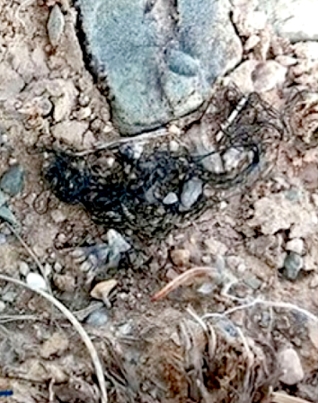Are there microbes that need to be protected?

Attempts are made to protect animals and plants that are rare and threatened with extinction, or they are at least included in the Red List of Threatened Species. There is no Red List for bacteria and archaea. However, collections of living microorganisms store thousands of microbial strains so that they can be made available to researchers worldwide for comparative studies. The preservation of biodiversity is not a priority, even if the strains include truly exotic organisms, and microbiologists can hardly say whether individual bacterial species or archaea are threatened with extinction. There is no overview of the worldwide occurrence of microbes. We also do not yet know most of the microbes. But sometimes drastic consequences become clear when a microbe species disappears from a habitat. For example, the man-made decline of the cyanobacterium Nostoc flagelliforme literally led to the devastation of a landscape.
Nostoc flagelliforme has always lived in large numbers on the arid steppes and in the mountainous regions of several provinces in north and north-west China. It grows in spaghetti-like long, thin threads and lies in clumps on the steppe floor (illustration). In Asia it is known as hair moss, hair herb or hair vegetable and has been collected, used as food and traded by the rural population for hundreds of years. Facai is the local name (in Mandarin) for the hair vegetable, and it sounds similar to a greeting and wish for the Chinese New Year ("be happy and rich"). This gave rise to the tradition of serving facai in a soup as a New Year's dish. Chinese restaurants adopted the recipe in their menus and so the steppe dwellers collected more and more hair moss. This was because it could not be artificially cultivated into long threads. Demand has been increasing since the 1970s, supplies became scarcer and the price climbed to over 120 dollars per kilo in 2000. Nostoc, aka facai, became a luxury food. Then the government suddenly banned wild collection, threatening and implementing drastic punitive measures, and placed Nostoc flagelliforme under protection.
Cyanobacteria have a special ability that only occurs in bacteria. They can bind atmospheric nitrogen (N2) and convert it into ammonium (NH4+), which is needed for the formation of amino acids, nucleic acids and many other biomolecules. Nitrogen salts are rare in the steppe and so grass and other plants only thrived as long as Nostoc fertilised the soil with sufficient organic nitrogen. The excessive collection of bacterial cultures impoverished the soil, grass and plants declined, the soil eroded and almost 20 per cent of the steppe in Inner Mongolia became desert. As storms blew more and more sand into Beijing and Shanghai, people began to look for the cause.
By the way, you can still order facai or fat choi (Cantonese) in restaurants. Nostoc flagelliforme has been tacitly replaced by coloured starch threads.
Read more
Mikrobe des Jahres 2014: Nostoc
H. Engelhardt (2014) Mikrobe des Jahres 2014.
Nostoc – Vom Weichensteller der Evolution zum Genussmittel. Rundschau für Fleischhygiene und Lebensmittelüberwachung 7/2014, 245-248
H. Engelhardt (2014) Nostoc – Multitalent mit bewegter Vergangenheit. Biospektrum 2/14, 234-235.
© Text Harald Engelhardt / VAAM, engelhar[at]biochem.mpg.de, Nutzung gemäß CC 4.0
Abbildung: Das Cyanobakterium Nostoc flagelliforme, auch "Haarmoos" oder "Haargemüse", © X. Gao et al. (2016) Nutzung gemäß CC 4.0

